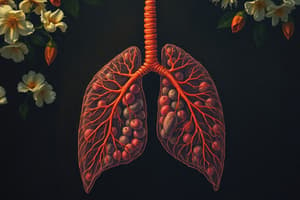Podcast
Questions and Answers
What is the primary function of the respiratory system?
What is the primary function of the respiratory system?
- To facilitate nutrient absorption in the intestines
- To regulate body temperature through perspiration
- To supply the body with oxygen and remove carbon dioxide (correct)
- To synthesize hormones for metabolic regulation
Which process involves the movement of air into and out of the lungs?
Which process involves the movement of air into and out of the lungs?
- Pulmonary ventilation (correct)
- External respiration
- Transport of gases
- Internal respiration
What is the role of cellular respiration in relation to the respiratory system?
What is the role of cellular respiration in relation to the respiratory system?
- It transports nutrients in the bloodstream
- It regulates blood pH levels
- It filters and humidifies the air we breathe
- It converts glucose into ATP using oxygen (correct)
Which zone of the respiratory system is responsible for gas exchange?
Which zone of the respiratory system is responsible for gas exchange?
What are the main functions of the nose in the respiratory process?
What are the main functions of the nose in the respiratory process?
How does the nasal cavity filter and condition the air we breathe?
How does the nasal cavity filter and condition the air we breathe?
What is the purpose of the conducting zone in the respiratory system?
What is the purpose of the conducting zone in the respiratory system?
What waste product is removed by the respiratory system during cellular respiration?
What waste product is removed by the respiratory system during cellular respiration?
What is the primary function of the nasal conchae in the respiratory system?
What is the primary function of the nasal conchae in the respiratory system?
Which of the following accurately describes the function of the oropharynx?
Which of the following accurately describes the function of the oropharynx?
What structural feature of the larynx aids in vocalization?
What structural feature of the larynx aids in vocalization?
How do the trachea and bronchi prevent collapse during respiration?
How do the trachea and bronchi prevent collapse during respiration?
What is alveolar ventilation and why is it crucial?
What is alveolar ventilation and why is it crucial?
What occurs to intrapulmonary pressure during inhalation?
What occurs to intrapulmonary pressure during inhalation?
Why is intrapleural pressure important for lung function?
Why is intrapleural pressure important for lung function?
What role does surfactant play in the alveoli?
What role does surfactant play in the alveoli?
What is the definition of tidal volume?
What is the definition of tidal volume?
How is vital capacity calculated?
How is vital capacity calculated?
What physiological condition is described by insufficient alveolar ventilation?
What physiological condition is described by insufficient alveolar ventilation?
How do oxygen and carbon dioxide move across the respiratory membrane?
How do oxygen and carbon dioxide move across the respiratory membrane?
What is the primary role of hemoglobin in the blood?
What is the primary role of hemoglobin in the blood?
What impact does a lower pH have on hemoglobin's oxygen affinity?
What impact does a lower pH have on hemoglobin's oxygen affinity?
Which factors influence the activity of the medullary respiratory centre?
Which factors influence the activity of the medullary respiratory centre?
What consequence does hyperventilation have on carbon dioxide levels?
What consequence does hyperventilation have on carbon dioxide levels?
Flashcards
Pulmonary Ventilation
Pulmonary Ventilation
Movement of air into and out of the lungs.
Respiratory System's Primary Function
Respiratory System's Primary Function
Supply the body with oxygen and remove carbon dioxide.
External Respiration
External Respiration
Gas exchange between alveoli and blood.
Internal Respiration
Internal Respiration
Signup and view all the flashcards
Cellular Respiration's Role
Cellular Respiration's Role
Signup and view all the flashcards
Respiratory Zone
Respiratory Zone
Signup and view all the flashcards
Conducting Zone's Role
Conducting Zone's Role
Signup and view all the flashcards
Nose's Functions
Nose's Functions
Signup and view all the flashcards
Nasal Conchae Function
Nasal Conchae Function
Signup and view all the flashcards
Pharynx Regions
Pharynx Regions
Signup and view all the flashcards
Larynx Function
Larynx Function
Signup and view all the flashcards
Trachea Support
Trachea Support
Signup and view all the flashcards
Intrapulmonary Pressure
Intrapulmonary Pressure
Signup and view all the flashcards
Alveolar Ventilation
Alveolar Ventilation
Signup and view all the flashcards
Intrapleural Pressure
Intrapleural Pressure
Signup and view all the flashcards
Surfactant Function
Surfactant Function
Signup and view all the flashcards
Tidal Volume
Tidal Volume
Signup and view all the flashcards
Inspiratory Reserve Volume
Inspiratory Reserve Volume
Signup and view all the flashcards
Expiratory Reserve Volume
Expiratory Reserve Volume
Signup and view all the flashcards
Residual Volume
Residual Volume
Signup and view all the flashcards
Vital Capacity
Vital Capacity
Signup and view all the flashcards
Hypoventilation
Hypoventilation
Signup and view all the flashcards
Hyperventilation
Hyperventilation
Signup and view all the flashcards
Partial Pressure Gradients
Partial Pressure Gradients
Signup and view all the flashcards
Study Notes
Respiratory System I & II
- Primary function: Supply the body with oxygen and remove carbon dioxide.
Respiratory Processes
- Pulmonary ventilation: Movement of air into and out of the lungs.
- External respiration: Gas exchange between alveoli and blood (oxygen enters blood, carbon dioxide leaves).
- Transport of gases: Oxygen and carbon dioxide transport in the blood between lungs and body tissues.
- Internal respiration: Gas exchange between blood in systemic capillaries and tissue cells (oxygen diffuses in, carbon dioxide diffuses out).
Cellular Respiration's Role
- Cells use oxygen to convert glucose to ATP (energy).
- Carbon dioxide is a byproduct, removed by the respiratory system.
Respiratory Zone vs. Conducting Zone
- Respiratory zone: Site of gas exchange (alveoli).
- Conducting zone: Pathway for air to reach respiratory zone (filters, warms, humidifies air).
Nose Functions
- Airway
- Filters and moistens air
- Warms air
- Resonating chamber for speech
- Houses olfactory receptors
Nasal Cavity Filtering
- Mucus lining traps particles.
- Ciliated cells move mucus to throat.
- Capillaries warm air.
Pharynx Regions
- Nasopharynx: Air passageway (closes during swallowing).
- Oropharynx: Food and air passageway (lined with protective epithelium).
- Laryngopharynx: Directs food and air to correct channels (continuous with esophagus).
Larynx Structure & Function
- Connects pharynx to trachea.
- Open airway.
- Food and air passageway.
- Houses vocal cords (speech).
Trachea & Bronchi Structure
- Hyaline cartilage rings in trachea prevent collapse.
- Bronchi branches have cartilage plates, decrease as airways narrow.
Alveolar Ventilation
- Amount of air entering alveoli per minute.
- Essential for adequate gas exchange, fresh oxygen delivery, and carbon dioxide removal.
Intrapulmonary Pressure vs. Atmospheric Pressure
- Inhalation: Intrapulmonary pressure drops below atmospheric pressure, drawing air into lungs.
- Exhalation: Intrapulmonary pressure rises above atmospheric pressure, pushing air out of lungs.
Intrapleural Pressure
- Always negative relative to intrapulmonary pressure.
- Maintains lung inflation by keeping lungs adhered to thoracic wall (expands and recoils with breathing).
Surfactant Function
- Produced by type II alveolar cells.
- Reduces surface tension in alveoli, preventing collapse during exhalation.
Lung Volumes
- Tidal volume: Air moved in/out with normal breath.
- Inspiratory reserve volume: Extra air inhaled beyond tidal volume.
- Expiratory reserve volume: Extra air exhaled beyond tidal volume.
- Residual volume: Air remaining in lungs after maximum exhalation.
- Vital capacity: Sum of tidal volume, inspiratory reserve volume, and expiratory reserve volume (maximum exhalation followed by maximum inhalation).
Hypoventilation & Hyperventilation
- Hypoventilation: Insufficient alveolar ventilation, low oxygen and high carbon dioxide, hypoxemia.
- Hyperventilation: Excessive alveolar ventilation, increased oxygen and reduced carbon dioxide, respiratory alkalosis.
Partial Pressure Gradients
- Oxygen and carbon dioxide move down their partial pressure gradients across respiratory membrane.
Hemoglobin Role in Oxygen Transport
- Hemoglobin carries most oxygen in blood.
- Affected by temperature and pH (lower pH and higher temperature reduces hemoglobin's affinity for oxygen, facilitating release to tissues—Bohr effect).
Medullary Respiratory Centre
- Regulates breathing rhythm.
- Controlled by levels of carbon dioxide, oxygen, pH, and peripheral and central chemoreceptors.
Studying That Suits You
Use AI to generate personalized quizzes and flashcards to suit your learning preferences.




